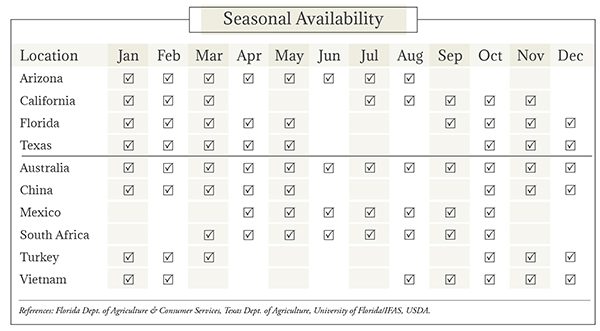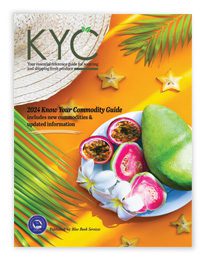Grapefruit Market Summary


Image: aquatarkus/Shutterstock.com
Grapefruit Market Overview
Most believe grapefruit originated in the Caribbean islands, specifically Barbados, in the 1700s where it was also called ‘forbidden fruit’ by islanders due to biblical references to the Garden of Eden. Grapefruit’s ancestors, pomelos (Citrus maxima, for largest citrus) and oranges (Citrus sinensis, sometimes referred to as Shaddocks, named for sea captain who brought orange seeds to Jamaica in the 1600s), trace their roots to Asia. Scottish botanist James MacFayden was the first to study grapefruit scientifically. While in Jamaica in the 1830s, he mistakenly thought the fruit was a spontaneous mutation of a pomelo and gave it the botanical name of Citrus paradisi. This name was amended in 1948 to Citrus x paradisi after research scientists agreed grapefruit was not a mutation but rather an accidental or natural hybrid of a pomelo and sweet orange. Most credit the fruit’s common-use name of grapefruit, instead of pomelo, to how it grows on trees. Some credit a Jamaican grower for the term, others say it was after the fruit arrived in Florida and was cultivated by locals. Either way, grapefruit has been in use since the 1800s due to how the fruit develops as small yellow globes in clusters, similar to grapes. Use of the less exotic name dismayed suppliers, however, who preferred the already established ‘pomelo’ moniker. The result caused confusion for sellers and buyers alike. Nationwide, commercial grapefruit groves have continued to dwindle. Florida still dominates the U.S. industry, though acreage has fallen significantly in the last few decades. Domestically, Texas, California, and Arizona produce the fruit commercially as well. China, which leads global production in both grapefruit and pomelos, began its ascendancy in the 1980s when the United States was the world’s top producer. At the time, Israel, Argentina, Cuba, and South Africa were also strong suppliers. China took the top slot by 2006 and now accounts for more than half of all grapefruit produced worldwide. Even so, due to high domestic consumption, China still imports grapefruit on an annual basis. Its top supplier has become South Africa, with shipments coming from other producers ranging from Thailand and Taiwan to Israel, Egypt, and Australia. Vietnam is a distant second to China in total production, with the United States and Mexico ranking closely at third and fourth, with each contributing about 5% of the world’s grapefruit supply. South Africa rounds out the top five in production, and is also among the world’s top exporters. Other producers include Thailand, India, Sudan, and Turkey; Israel, Argentina, and Cuba are a fraction of their former production.

Types & Varieties of Grapefruit
The outer color of grapefruit can range from light to golden yellow, orange, or with a tinge of green. The flesh, segmented like other citrus fruit, varies in color from white to pink to vibrant red, and can be seeded or seedless. Flavor revolves around variety, though many consider color as the determining factor: the redder the flesh, the sweeter the taste (though this isn’t always true). Overall, some grapefruit are sweet or semisweet due to lower acidity (generally darker pink or red flesh), some are tart, and others are characteristically bitter. Although there are many grapefruit varieties, they are divided into two main groups by flesh coloring: red/pink and white/ yellow. Colorful names abound for grapefruit from Flame, Ruby Red (patented in the Rio Grande Valley in South Texas back in 1929), Rio Red, Star, Star Rudy, and Lavender Gem (for red or pink flesh); as well as Duncan, Marsh, White Marsh, Melo Gold, Oroblanco, and Triumph (for white or yellow flesh).
Cultivation of Grapefruit
Grapefruit trees can grow to a height of 20 feet or higher, depending on the age of the tree. Branches are covered with long glossy green leaves and short thorns. Although trees can grow in a variety of soil types, the key is to ?nd a rootstock best suited to the soil, available moisture, and temperature. Trees grow well in warm, subtropical climates as temperature affects the flowering-to-fruit maturity timeline. Even within the same geographic area or state, the warmer the temperature, the shorter the flowering period. Dry, subtropical weather yields thicker, rough rinds and low juice; higher humidity produces more desirable fruit with softer rinds and higher juice content. Grapefruit is usually harvested fully ripe with shiny, smooth skin and a solid heft. Mature fruit is often picked by hand. Machine harvesting requires the removal of lower branches to make room for catching; this type of harvesting is limited to less delicate varieties. Although mechanical harvesting can cause super?cial damage, it can yield far more fruit in less time, and is commonplace for fruit headed to juicers. Grapefruit does not ripen after harvest, though ethylene can be used to de-green the fruit to a yellow hue. Too much or prolonged ethylene exposure will age the peel more than the ?esh, leaving fruit susceptible to decay.
Pests & Diseases Affecting Grapefruit
Citrus leafminer larvae create shallow tunnels or mines as they feed on young leaves. Mines become more noticeable as the larvae grow, making the damage more noticeable, but it generally isn’t so significant that it causes irreparable harm or damage to the tree. Aphids feed on the moisture inside leaves and secrete a sticky substance that attracts ants, which do not harm the tree but serve as an indicator of infestation. Other pests of concern for grapefruit and citrus in general include aphids, beetles, fruit flies, mealybugs, mites, moths, and thrips. Green mold spores are produced by fungus on the surface of infected fruit and are airborne, making it difficult to control. Green spores are surrounded by a rim of white on infected fruit. Blue, pink, and grey mold can cause problems as well. Brown rot is a fungus typically associated with high rainfall and restricted air and/or water drainage. Typically, a single application of fungicide is enough to protect fruit. Stem end rot is a major decay of the fruit that starts at each end and works its way down the sides. Other disease or virus threats include anthracnose, blight, citrus canker, damping-off, dieback, fusarium, scab, sooty blotch, and various ‘spot’ disorders including black, leaf, greasy, and tar spot.Storage & Packaging of Grapefrtuit
Grapefruit is shipped in cartons or crates and can be part of mixed loads, though careful monitoring of temperature, humidity, and ethylene levels is required. Optimum storage temperature for up to 6 weeks is 54 to 57°F with 85 to 95% relative humidity. Temperatures below 50°F will cause chilling injury. References: Florida Department of Citrus, Purdue University, Texas A&M University, University of California, University of Florida/IFAS Extension, University of Illinois Extension, U.S. Citrus, USDA Foreign Agricultural Service.Grades & Good Arrival of Grapefruit
The U.S.’s top producers of grapefruit (Florida, Texas, California, and Arizona) have their own specific USDA grade standards, ranging from U.S. Fancy and U.S. No. 1 to various lower grades.Generally speaking, the percentage of defects shown on a timely government inspection certificate should not exceed the percentage of allowable defects, provided: (1) transportation conditions were normal; (2) the USDA or CFIA inspection was timely; and (3) the entire lot was inspected.
ARIZONA & CALIFORNIA
| U.S. Grade Standards | Days Since Shipment | % of Defects Allowed | Optimum Transit Temp. (°F) |
| 12 [7 VSD]-3 | 5 4 3 2 1 | 15-[8 VSD]-5 15-[8 VSD]-5 14-[8 VSD]-4 13-[7 VSD]-4 12-[7 VSD]-3 | 58-60° |
FLORIDA
| U.S. Grade Standards | Days Since Shipment | % of Defects Allowed | Optimum Transit Temp. (°F) |
| 12 [7 VSD]-3 | 5 4 3 2 1 | 15-[8 VSD]-5 15-[8 VSD]-5 14-[7 VSD]-4 13-[7 VSD]-4 12-[7 VSD]-3 | 50-60° |
TEXAS & OTHER STATES
| U.S. Grade Standards | Days Since Shipment | % of Defects Allowed | Optimum Transit Temp. (°F) |
| see standards | 5 4 3 2 1 | 15-[8 VSD]-4 14-[8 VSD]-4 13-[7 VSD]-3 12-[6 VSD]-2 10-[5 VSD]-2 | 50-60° |
References: DRC, PACA, USDA.
Grapefruit Retail Pricing: Conventional & Organic Per Pound



